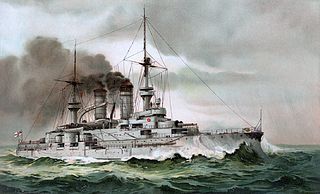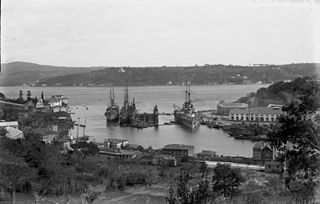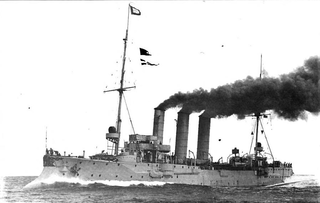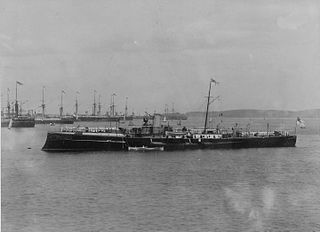
SMS Ariadne was the fifth member of the ten-ship Gazelle class of light cruisers that were built for the German Kaiserliche Marine in the late 1890s and early 1900s. The Gazelle class was the culmination of earlier unprotected cruiser and aviso designs, combining the best aspects of both types in what became the progenitor of all future light cruisers of the Imperial fleet. Built to be able to serve with the main German fleet and as a colonial cruiser, she was armed with a battery of ten 10.5 cm (4.1 in) guns and a top speed of 21.5 knots.

The Wittelsbach-class battleships were a group of five pre-dreadnought battleships built for the German Kaiserliche Marine in the early 1900s. They were the first battleships ordered under the Second Navy Law of 1898, part of Admiral Alfred von Tirpitz's fleet expansion program. The class comprised the lead ship, Wittelsbach, and Wettin, Zähringen, Schwaben, and Mecklenburg. All five ships were laid down between 1899 and 1900 and were finished by 1904. The ships of the Wittelsbach class were similar in appearance to their predecessors in the Kaiser Friedrich III class, but had a more extensive armor belt and a flush main deck, as opposed to the lower quarterdeck of the previous class. Both classes carried a battery of four 24 cm (9.4 in) guns in two twin-gun turrets.

The Mediterranean Division was a division consisting of the battlecruiser SMS Goeben and the light cruiser SMS Breslau of the German Kaiserliche Marine in the early 1910s. It was established in response to the First Balkan War and saw action during the First World War. It was disbanded after the ships were transferred to the Ottoman Empire four years after their pursuit by the British battlecruisers Indomitable and Indefatigable and light cruisers Dublin and Gloucester.

SMS Danzig was a light cruiser of the Imperial German Navy. Named for the city of Danzig, she was the seventh and last ship of the Bremen class. She was begun by the Imperial Dockyard in her namesake city in 1904, launched on 23 September 1905 and commissioned on 1 December 1907. Armed with a main battery of ten 10.5 cm (4.1 in) guns and two 45 cm (18 in) torpedo tubes, Danzig was capable of a top speed of 22 knots.

SMS Nymphe was the third member of the ten-ship Gazelle class of light cruisers that were built for the German Kaiserliche Marine in the late 1890s and early 1900s. The Gazelle class was the culmination of earlier unprotected cruiser and aviso designs, combining the best aspects of both types in what became the progenitor of all future light cruisers of the Imperial fleet. Built to be able to serve with the main German fleet and as a colonial cruiser, she was armed with a battery of ten 10.5 cm (4.1 in) guns and a top speed of 21.5 knots.

SMS Hamburg was the second member of the seven-vessel Bremen class of light cruisers, built for the German Kaiserliche Marine in the early 1900s. She and her sister ships were ordered under the 1898 Naval Law that required new cruisers be built to replace obsolete vessels in the fleet. The design for the Bremen class was derived from the preceding Gazelle class, utilizing a larger hull that allowed for additional boilers that increased speed. Named for the city of Hamburg, the ship was armed with a main battery of ten 10.5 cm (4.1 in) guns and had a top speed of 22 knots.

SMS Lübeck was the fourth of seven Bremen-class cruisers of the Imperial German Navy, named after the city of Lübeck. She was begun by AG Vulcan Stettin in Stettin in 1903, launched in March 1904 and commissioned in April 1905. Armed with a main battery of ten 10.5 cm (4.1 in) guns and two 45 cm (18 in) torpedo tubes, Lübeck was capable of a top speed of 22.5 knots.

SMS Prinzess Wilhelm was a protected cruiser of the German Imperial Navy. She was the second Irene-class cruiser; her only sister ship was SMS Irene. Prinzess Wilhelm was laid down in 1886 at the Germaniawerft shipyard in Kiel, launched in September 1887, and commissioned into the fleet in November 1889. The cruiser was named after Augusta Victoria of Schleswig-Holstein, first wife of Kaiser Wilhem II. As built, the ship was armed with a main battery of fourteen 15 cm (5.9 in) guns and had a top speed of 18 knots.

The Bismarck-class corvettes were a class of six corvettes built for the German Kaiserliche Marine in the 1870s. The six ships were Bismarck, Blücher, Stosch, Moltke, Gneisenau, and Stein. The Bismarck-class corvettes were ordered as part of a major naval construction program in the early 1870s, and they were designed to serve as fleet scouts and on extended tours in Germany's colonial empire. The ships were armed with a battery of between ten and sixteen 15 cm (5.9 in) guns and they had a full ship rig to supplement their steam engine on long cruises abroad. One ship, Blücher, was converted into a torpedo testing and training ship shortly after she was completed, having her guns replaced with a variety of torpedo launchers.

SMS Pfeil was an aviso of the Imperial German Navy, the second and final member of the Blitz class. Her primary offensive armament consisted of a bow-mounted torpedo tube, and she was armed with a battery of light guns to defend herself against torpedo boats, a sign of the growing importance of torpedoes as effective weapons in the period. The Blitz class featured a number of innovations in German warship design: they were the first steel hulled warships and the first cruiser-type ships to discard traditional sailing rigs.

The Blitz class was a pair of avisos built for the German Kaiserliche Marine in the early 1880s. The ships, Blitz and Pfeil, were the first steel-hulled ships of any kind built by the German Navy, were among the first torpedo cruiser type warships in the world, and were the progenitors of the later light cruisers of the Gazelle class. They were armed with a 12.5 cm (4.9 in) gun and one 35 cm (13.8 in) torpedo tube as their principal armament, and were capable of a top speed in excess of 15 knots. They were very successful warships, remaining in active service for more than three decades.

The Wacht class was a pair of avisos built by the German Kaiserliche Marine in the late-1880s; the class comprised two ships, Wacht and Jagd. They were laid down in 1886 and 1887 and completed by 1888 and 1889, respectively. The ships were based on the previous aviso, SMS Greif, which had proved to be an unsuccessful design due to its lack of torpedo armament. As a result, the Wacht-class ships were equipped with three torpedo tubes to improve their combat power; they were also the first German avisos to carry armor protection.

SMS Jagd was an aviso of the Imperial German Navy, the second and final member of the Wacht class. She had one sister ship, Wacht. Jagd was laid down in 1887 at the AG Weser shipyard, launched in July 1888, and commissioned in June 1889. She served in the German fleet for the next fifteen years, until she was withdrawn from active duty in 1904. Thereafter, she was used as a harbor ship. In 1910, she was stricken from the naval register and hulked. She was later used as a torpedo training platform until 1920, when she was sold for scrapping.

The Carola class was a group of six screw corvettes built by the German Kaiserliche Marine in the late 1870s and 1880s. The class comprised Carola, the lead ship, Olga, Marie, Sophie, Alexandrine, and Arcona. They were ordered to replace older sailing vessels that were no longer sufficient to protect German interests around the world. Intended for service in the German colonial empire, the ships were designed with a combination of steam and sail power for extended cruising range, and they were equipped with a battery of ten 15-centimeter (5.9 in) guns. Relying primarily on sail power for their long-range deployments, the ships were obsolescent before construction began.

The Ariadne class was a group of three screw corvettes of the North German Federal Navy and Imperial Navy, built in the 1860s and 1870s. The class comprised three ships: Ariadne, Luise, and Freya. The first two vessels were identical, but Freya was built to a modified design with a longer hull, which allowed her to carry more powerful engines and additional coal for the boilers. The ships were ordered as part of a naval construction program directed at strengthening the North German Federal Navy, though by the time they entered service, all of the German states had united into the German Empire. They were intended to serve on extended cruises abroad, protecting German interests overseas. Their primary armament consisted of six or eight 15 cm (5.9 in) guns, and they were fitted with full ship rigs to supplement their steam engines on long voyages abroad.

SMS Loreley was an aviso of the Prussian Navy built in the late 1850s. Built as a paddle steamer, since the Prussian naval command was not convinced of the reliability of screw propellers, she was the first Prussian warship to be fitted with a domestically-produced marine steam engine. The ship carried a light armament of two 12-pound guns and had a top speed of 10.5 knots. Loreley was intended to serve as the flagship of the gunboat flotillas that formed the bulk of the Prussian fleet in the 1850s.

SMS Pommerania was a paddle steamer originally built for use as a packet ship but was acquired by the North German Federal Navy in 1870 during the Franco-Prussian War. Commissioned too late to see service during the conflict, she was initially used to conduct fishery surveys that were later used as the basis for the German Fisheries Act in 1874. Pommerania went to the Mediterranean Sea in 1876 in response to the murder of a German diplomat and remained in the region to observe the Russo-Turkish War of 1877–1878. After returning to Germany in 1879, she spent much of the 1880s either operating as a fishery protection vessel or conducting surveys of the German coastline. Decommissioned in 1889, she was struck from the naval register in 1890, sold in 1892, and was converted into a sailing schooner. She was renamed Adler, but was lost with all hands on her first voyage as a merchant ship in January 1894.
















